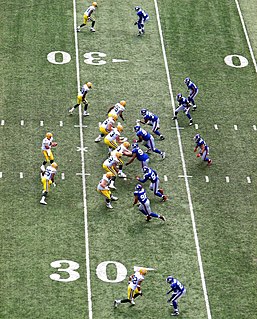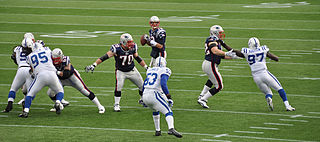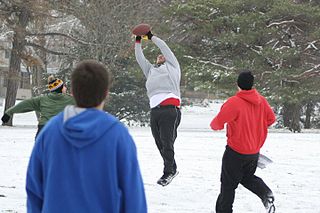
The shotgun formation is a formation used by the offensive team in gridiron football. This formation is used mainly for passing plays, although some teams use it as their base formation. In the shotgun, instead of the quarterback receiving the snap from center at the line of scrimmage, he stands farther behind the line of scrimmage, often five to seven yards back. Sometimes the quarterback will have a back on one or both sides before the snap, while other times he will be the lone player in the backfield with everyone spread out as receivers.

A running back (RB) is a gridiron football position, a member of the offensive backfield. The primary roles of a running back are to receive handoffs from the quarterback for a rushing play, to catch passes from out of the backfield, and to block. There are usually one or two running backs on the field for a given play, depending on the offensive formation. A running back may be a halfback, a wingback or a fullback. A running back will sometimes be called a "feature back" if he is the team's starting running back.

In gridiron football, a lineman is a player who specializes in play at the line of scrimmage. The linemen of the team currently in possession of the ball are the offensive line, while linemen on the opposing team are the defensive line. A number of NFL rules specifically address restrictions and requirements for the offensive line, whose job is to help protect the quarterback from getting sacked for a loss, or worse, fumbling. The defensive line is covered by the same rules that apply to all defensive players. Linemen are usually the largest players on the field in both height and weight, since their positions usually require less running and more strength than skill positions.

A cornerback (CB) is a member of the defensive backfield or secondary in gridiron football. Cornerbacks cover receivers most of the time, and defend against offensive plays by creating turnovers or deflecting forward passes rather than making a tackle. Other members of the defensive backfield include the safeties and occasionally linebackers. The cornerback position requires speed, agility, and strength. A cornerback's skill set typically requires proficiency in anticipating the quarterback, backpedaling, executing single and zone coverage, disrupting pass routes, block shedding, and tackling. Cornerbacks are among the fastest players on the field.

A linebacker is a playing position in gridiron football. Linebackers are members of the defensive team, and line up approximately three to five yards behind the line of scrimmage, behind the defensive linemen, and therefore "back up the line". Linebackers generally align themselves before the ball is snapped by standing upright in a "two-point stance".
In American football, the West Coast offense is an offense that places a greater emphasis on passing than on running.
A screen pass is a play in gridiron football consisting of a short pass to a receiver who is protected by a screen of blockers. During a screen pass, a number of things happen concurrently in order to fool the defense into thinking a long pass is being thrown, when in fact the pass is merely a short one, just beyond the defensive linemen. Screens are usually deployed against aggressive defenses that rush the passer. Because screens invite the defense to rush the quarterback, they are designed to leave fewer defensemen behind the rushers to stop the play.
A draw play, or simply draw for short, is a type of American football play. The draw is a running play disguised as a passing play. It is the opposite of a play-action pass, which is a passing play disguised as a running play. The play is often used in long yardage situations.

Defensive end (DE) is a defensive position in the sport of gridiron football.
Strategy forms a major part of the game of American football, and both teams plan many aspects of their plays (offense) and response to plays (defense), such as what formations they take, who they put on the field, and the roles and instructions each player are given. Throughout a game, each team adapts to the other's apparent strengths and weaknesses, trying various approaches to outmaneuver or overpower their opponent to score more points in order to win the game.

The 46 defense is an American football defensive formation, an eight men in the box defense, with six players along the line of scrimmage. There are two players at linebacker depth playing linebacker technique, and then three defensive backs. The 46 defense was originally developed and popularized with the Chicago Bears by their defensive coordinator Buddy Ryan, who later became head coach of the Philadelphia Eagles and Arizona Cardinals.
In American football, a zone blitz is a defensive tactic that sends additional players to rush the opposing team's quarterback, whilst also unexpectedly redirecting a supposed pass rushing player into pass coverage instead. This tactic also likely includes zone coverage.

The passing pocket, or the pocket, is a term used in American football to describe the area in the backfield created on a passing play where the offensive line forms a wall of protection around the quarterback. This allows him adequate time to find an open receiver and to pass the ball. The offensive line will drop back slightly, creating a U-shaped protected area for the quarterback to find an open receiver and pass the ball.

The Tampa 2 is an American football defensive scheme popularized by the Tampa Bay Buccaneers National Football League (NFL) team in the mid-1990s–early 2000s. The Tampa 2 is typically employed out of a 4–3 defensive alignment, which consists of four linemen, three linebackers, two cornerbacks, and two safeties. The defense is similar to a Cover 2 defense, except the middle linebacker drops into a deep middle coverage for a Cover 3 when he reads a pass play.

In American football each team has 11 players on the field at one time. The specific role that a player takes on the field is called their position. Under the modern rules of American football, teams are allowed unlimited substitutions; that is, teams may change any number of players after any play. This has resulted in the development of three "platoons" of players: the offense, the defense, and the special teams. Within those platoons, various specific positions exist depending on what each player's main job is.

Street football, also known as backyard football or sandlot football, is a simplified variant of American football primarily played informally by youth. It features far less equipment and fewer rules than its counterparts, but unlike the similar touch football, features full tackling.
In American football a play is a close to the ground "plan of action" or "strategy" used to move the ball down the field. A play begins at either the snap from the center or at kickoff. Most commonly plays occur at the snap during a down. These plays range from basic to very intricate. Football players keep a record of these plays in their playbook.

Zone coverage is a defense scheme in gridiron football used to protect against the pass.
The following terms are used in American football, both conventional and indoor. Some of these terms are also in use in Canadian football; for a list of terms unique to that code, see Glossary of Canadian football.











